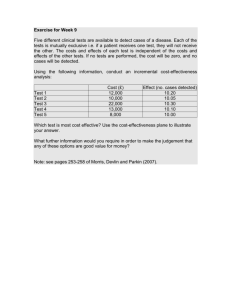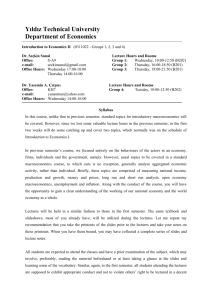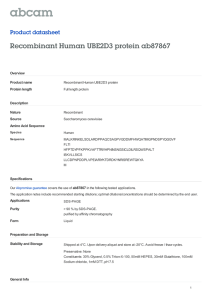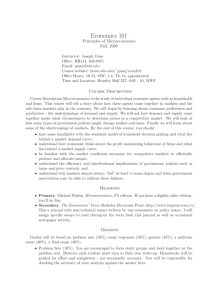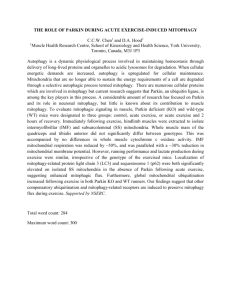Anti-Parkin (phospho S101) antibody ab73015 Product datasheet 1 Image Overview
advertisement
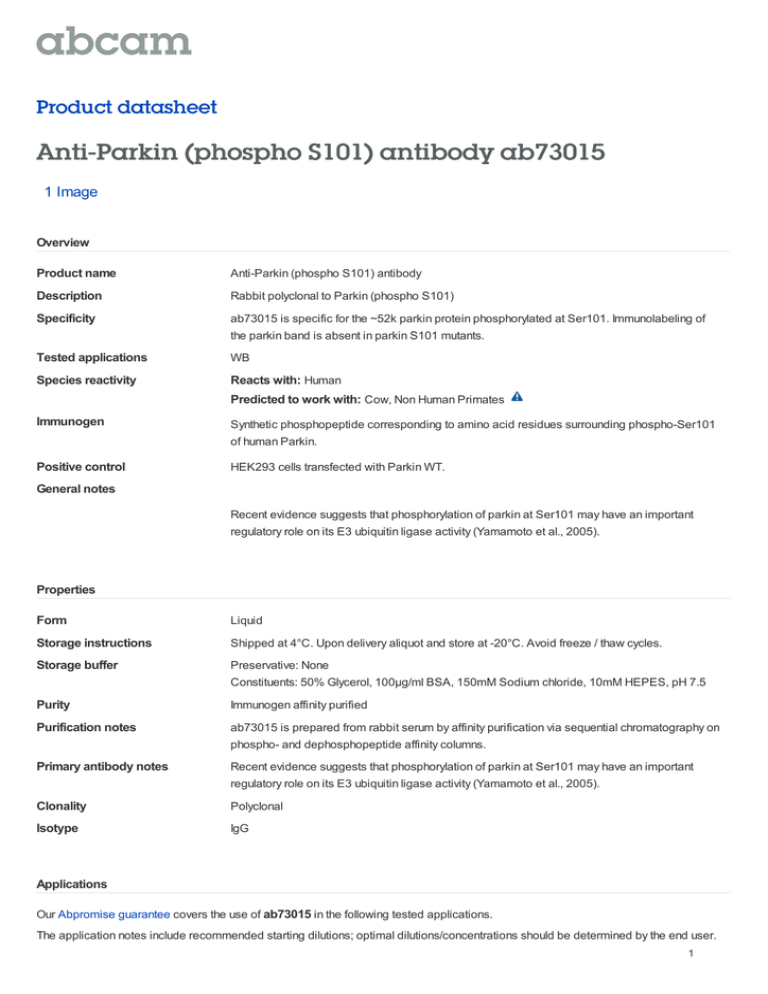
Product datasheet Anti-Parkin (phospho S101) antibody ab73015 1 Image Overview Product name Anti-Parkin (phospho S101) antibody Description Rabbit polyclonal to Parkin (phospho S101) Specificity ab73015 is specific for the ~52k parkin protein phosphorylated at Ser101. Immunolabeling of the parkin band is absent in parkin S101 mutants. Tested applications WB Species reactivity Reacts with: Human Predicted to work with: Cow, Non Human Primates Immunogen Synthetic phosphopeptide corresponding to amino acid residues surrounding phospho-Ser101 of human Parkin. Positive control HEK293 cells transfected with Parkin WT. General notes Recent evidence suggests that phosphorylation of parkin at Ser101 may have an important regulatory role on its E3 ubiquitin ligase activity (Yamamoto et al., 2005). Properties Form Liquid Storage instructions Shipped at 4°C. Upon delivery aliquot and store at -20°C. Avoid freeze / thaw cycles. Storage buffer Preservative: None Constituents: 50% Glycerol, 100µg/ml BSA, 150mM Sodium chloride, 10mM HEPES, pH 7.5 Purity Immunogen affinity purified Purification notes ab73015 is prepared from rabbit serum by affinity purification via sequential chromatography on phospho- and dephosphopeptide affinity columns. Primary antibody notes Recent evidence suggests that phosphorylation of parkin at Ser101 may have an important regulatory role on its E3 ubiquitin ligase activity (Yamamoto et al., 2005). Clonality Polyclonal Isotype IgG Applications Our Abpromise guarantee covers the use of ab73015 in the following tested applications. The application notes include recommended starting dilutions; optimal dilutions/concentrations should be determined by the end user. 1 Application WB Abreviews Notes 1/1000. Detects a band of approximately 52 kDa (predicted molecular weight: 52 kDa). Target Function Functions within a multiprotein E3 ubiquitin ligase complex, catalyzing the covalent attachment of ubiquitin moieties onto substrate proteins, such as BCL2, SYT11, CCNE1, GPR37, STUB1, a 22 kDa O-linked glycosylated isoform of SNCAIP, SEPT5, ZNF746 and AIMP2. Mediates monoubiquitination as well as 'Lys-48'-linked and 'Lys-63'-linked polyubiquitination of substrates depending on the context. Participates in the removal and/or detoxification of abnormally folded or damaged protein by mediating 'Lys-63'-linked polyubiquitination of misfolded proteins such as PARK7: 'Lys-63'-linked polyubiquitinated misfolded proteins are then recognized by HDAC6, leading to their recruitment to aggresomes, followed by degradation. Mediates 'Lys-63'-linked polyubiquitination of SNCAIP, possibly playing a role in Lewy-body formation. Mediates monoubiquitination of BCL2, thereby acting as a positive regulator of autophagy. Promotes the autophagic degradation of dysfunctional depolarized mitochondria. Mediates 'Lys-48'-linked polyubiquitination of ZNF746, followed by degradation of ZNF746 by the proteasome; possibly playing a role in role in regulation of neuron death. Limits the production of reactive oxygen species (ROS). Loss of this ubiquitin ligase activity appears to be the mechanism underlying pathogenesis of PARK2. May protect neurons against alpha synuclein toxicity, proteasomal dysfunction, GPR37 accumulation, and kainate-induced excitotoxicity. May play a role in controlling neurotransmitter trafficking at the presynaptic terminal and in calcium-dependent exocytosis. Regulates cyclin-E during neuronal apoptosis. May represent a tumor suppressor gene. Tissue specificity Highly expressed in the brain including the substantia nigra. Expressed in heart, testis and skeletal muscle. Expression is down-regulated or absent in tumor biopsies, and absent in the brain of PARK2 patients. Overexpression protects dopamine neurons from kainate-mediated apoptosis. Found in serum (at protein level). Pathway Protein modification; protein ubiquitination. Involvement in disease Defects in PARK2 are a cause of Parkinson disease (PARK) [MIM:168600]. A complex neurodegenerative disorder characterized by bradykinesia, resting tremor, muscular rigidity and postural instability. Additional features are characteristic postural abnormalities, dysautonomia, dystonic cramps, and dementia. The pathology of Parkinson disease involves the loss of dopaminergic neurons in the substantia nigra and the presence of Lewy bodies (intraneuronal accumulations of aggregated proteins), in surviving neurons in various areas of the brain. The disease is progressive and usually manifests after the age of 50 years, although early-onset cases (before 50 years) are known. The majority of the cases are sporadic suggesting a multifactorial etiology based on environmental and genetic factors. However, some patients present with a positive family history for the disease. Familial forms of the disease usually begin at earlier ages and are associated with atypical clinical features. Defects in PARK2 are the cause of Parkinson disease type 2 (PARK2) [MIM:600116]; also known as early-onset parkinsonism with diurnal fluctuation (EPDF) or autosomal recessive juvenile Parkinson disease (PDJ). A neurodegenerative disorder characterized by bradykinesia, rigidity, postural instability, tremor, and onset usually befor 40. It differs from classic Parkinson disease by early DOPA-induced dyskinesia, diurnal fluctuation of the symptoms, sleep benefit, dystonia and hyper-reflexia. Dementia is absent. Pathologically, patients show loss of dopaminergic neurons in the substantia nigra, similar to that seen in Parkinson disease; however, Lewy bodies (intraneuronal accumulations of aggregated proteins) are absent. Note=Defects in PARK2 may be involved in the development and/or progression of ovarian cancer. 2 Sequence similarities Belongs to the RBR family. Parkin subfamily. Contains 1 IBR-type zinc finger. Contains 2 RING-type zinc fingers. Contains 1 ubiquitin-like domain. Domain The ubiquitin-like domain binds the PSMD4 subunit of 26S proteasomes. Post-translational modifications Auto-ubiquitinates in an E2-dependent manner leading to its own degradation. Also polyubiquitinated by RNF41 for proteasomal degradation. S-nitrosylated. The inhibition of PARK2 ubiquitin E3 ligase activity by S-nitrosylation could contribute to the degenerative process in PD by impairing the ubiquitination of PARK2 substrates. Cellular localization Cytoplasm > cytosol. Nucleus. Endoplasmic reticulum. Mitochondrion. Mainly localizes in the cytosol. Co-localizes with SYT11 in neutrites. Co-localizes with SNCAIP in brainstem Lewy bodies. Relocates to dysfunctional mitochondria that have lost the mitochondial membrane potential; recruitement to mitochondria is PINK1-dependent. Anti-Parkin (phospho S101) antibody images All lanes : Anti-Parkin (phospho S101) antibody (ab73015) at 1/1000 dilution Lane 1 : HEK293 cells transfected with Parkin WT (phospho) Lane 2 : HEK293 cells transfected with Western blot - Parkin (phospho S101) antibody Parkin S101 mutant (non-phospho) (ab73015) Predicted band size : 52 kDa Observed band size : 52 kDa Please note: All products are "FOR RESEARCH USE ONLY AND ARE NOT INTENDED FOR DIAGNOSTIC OR THERAPEUTIC USE" Our Abpromise to you: Quality guaranteed and expert technical support Replacement or refund for products not performing as stated on the datasheet Valid for 12 months from date of delivery Response to your inquiry within 24 hours We provide support in Chinese, English, French, German, Japanese and Spanish Extensive multi-media technical resources to help you We investigate all quality concerns to ensure our products perform to the highest standards If the product does not perform as described on this datasheet, we will offer a refund or replacement. For full details of the Abpromise, please visit http://www.abcam.com/abpromise or contact our technical team. Terms and conditions Guarantee only valid for products bought direct from Abcam or one of our authorized distributors 3


